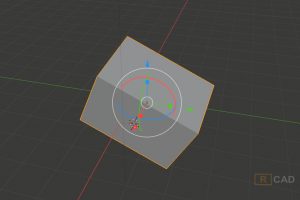

- #Blender 2.8 origin to geometry install
- #Blender 2.8 origin to geometry code
- #Blender 2.8 origin to geometry plus
Press x to delete them and you have one object containing all meshes that don't overlap with each other.Press Ctrl + L to extend to whole separate meshes of selected faces that Intersection gave you. The Intersection will give a result that consist of meshes in contact with each other by faces.From there, click on Intersection and go into Edit Mode

Select one active object from all of selected particles then Use Ctrl + J to join them.Go to Particle Properties and remove particle system from the surface object.Go to Modifier Properties and click on Convert to turn them into meshes. In Blender, go to Edit Preferences Addons then tick 3D Mesh Toolbox in Official list addons.Have desired particles on surface first.(There is an issue, the method won't let you accept color random node for the particle system and instead it will produce one randomized color for all of your meshes) And don’t forget to change the transformation axis to Local to see the effect, of course. Both are used with denoise node in Composite. The option is found in the Options button dropdown menu or type N to open the Sidebar and select the Tool tab. Here are the difference between overlapping and non-overlapping particles in those two pictures I used collection of objects as particles.


If too high, it will take considerably long time or Blender or computer may crash from extreme high poly objects. Note: Be sure to enlarge them if you only see origin points as they may be scaled down significantlyĪfter fumbling around this one, I had to use subdivision modifier on surface of object because if it's too low, vertices generated will be messy for particles clumping together from one point. You will be prompted with a dropper to select which object you want to pick for particles.Note: Make sure it is in emmiter instead of hair After generating the particles, go to Render from Particles Settings and select Object in Render as.Choose highest quality for more evenly spaced particles from the context menu(opens only when you initially make new Blue Noise Particles).Press Shift + A to open up Mesh menu and select Blue Noise Particles.Select the surface of the object you want to distribute your particles onto.
#Blender 2.8 origin to geometry install
#Blender 2.8 origin to geometry code
So the question is - If it's possible to make code for origin point and particle system and set restriction for within a certain distance of "first" particle so newer particles won't spawn within it but any other area than that, then can you show the code with this instructions in mind? For example, a sprinkle on donut has a distance of 5mm from another sprinkle, with both the origin points from two sprinkles as the radius to determine the set distance. It seams that parenting is a complex ordeal, so let me try to simplify it.
#Blender 2.8 origin to geometry plus
You can parent objects from five different windows: The 3D view, Properties Editor, Outliner, Text Editor and Console plus there is a daunting list of different parent types. And it occurred to me that the overlapping problem with particle system could be solved by using a script to restrict or block any particle from spawning within a set distance of a particle. There are many ways to parent objects in blender. The only way is to rotate the geometry but then the initial position and rotation of the object is gone.įund this script, but I am unable to make this to work with the official python sdk.While I was watching Blender Guru video for 2.8 Blender, he set the origin point of 5 different sprinkles in Set origin to geometry. Now in 2.8 the script doesn’t work anymore, and I am surprised, that there is absolutely no possible way in blender to rotate an origin at all. Once in 2.79 used a script for “Move origin to selection” which also aligned the local axis to the polygon normal.


 0 kommentar(er)
0 kommentar(er)
